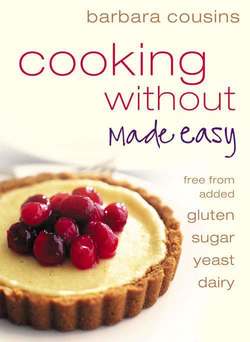Читать книгу Cooking Without Made Easy: All recipes free from added gluten, sugar, yeast and dairy produce - Barbara Cousins - Страница 34
Some guidance on recipes and ingredients
ОглавлениеServing size: I decided to make most of the recipes in this book feed two people, rather than four as in my previous books. This makes it easier for those of you who are cooking for one, as I know is often the case. The recipes are easy to halve for one, or double if you are cooking for four or want extra for the next day or the freezer. The soups still feed four as they all freeze so easily. I have tried to suggest lots of alternatives where possible in recipes, so that readers can work around likes and dislikes as well as allergies and intolerances.
Tablespoons and teaspoons: The spoons I have used when creating these recipes are measuring spoons.
Milk: Where recipes contain milk I have used soya milk, but others could be substituted. The choice is now wide and includes milk made from ingredients such as oats, rice, quinoa and almonds. However, while some milks are naturally sweet, others have sweeteners such as apple juice added and these would be less acceptable in savoury recipes. I’ve not been able to test all the milks available in all the recipes so take care as some may separate on heating.
Yogurt: Where recipes contain yogurt I have used soya yogurt, but this can often be replaced with goat or sheep’s yogurt or even coconut milk.
Soya Dream: I have suggested this as an alternative to cream for serving with desserts. It’s made from soya beans but does have fructose and glucose syrup added. It is readily available in supermarkets and health food shops.
Tomatoes: If necessary, tinned tomatoes can be replaced with carrot juice or stock, or even tinned lentils in some vegetarian dishes. Tomato puree can be omitted and other vegetables used instead of fresh tomatoes.
Lemon juice and lemon rind: I have used lemon juice and lemon rind to flavour some recipes but they could be omitted without too much detriment to the flavour. Vinegar can be used in salad dressings, if you do not have a problem with fermented foods, or another fruit juice, such as orange or pineapple, added. I like to freeze both lemon juice and lemon rind so that they are always to hand. I place the grated rind in containers and provided you don’t press it down, it’s easy to extract a teaspoon when needed. I freeze the juice in ice cube trays then decant into a storage container once frozen.
Pickled lemons: Whole lemons are preserved in brine and provide a wonderful Moroccan flavouring to dishes. Omit if you cannot tolerate citrus. For suppliers see the list at the back of this book.
Fruit juices: These can be substituted with other juices—try pineapple juice instead of orange juice and apple juice instead of grape.
Tamari sauce: This is a wheat-free alternative to soya sauce. It imparts a wonderful savoury flavour to recipes, but it is fermented, so avoid if you have Candida problems. It is useful for adding to dishes you feel are lacking in flavour, and is readily available in health food shops and some supermarkets.
Fish sauce: This adds a wonderful flavour to any savoury dishes and doesn’t really smell or taste fishy. It is made from anchovies, salt and 2 per cent sugar. It is fermented, so avoid it if you have Candida problems. Suppliers are listed at the back of the book, though it is now available in most supermarkets.
Horseradish sauce: A salt-pickled version, containing no dairy produce, is available. See the list of suppliers. This is not fermented, though a little lactic acid may be produced when it is processed. I also found a hot horseradish in my supermarket that was similar.
